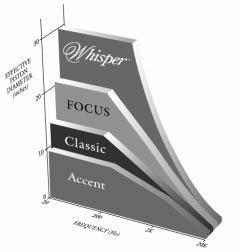-
Engineers Perspective
Technological Comparisons
Posted July 2011
Written by Bill Dudleston
Relying on an 8” driver to pump up your 2500 cubic foot listening space is like fanning yourself with a guitar pick. Distortion will rise and transient response will be compromised (unless you’ve recently devised a scheme for miniaturizing a 30-foot wavelength). The laws of physics dictate that a loudspeaker’s effective radiating diameter should increase proportionally with the wavelength of sound to provide consistently low distortion, broad dynamic range and uniform power distribution.
Study the chart. Note how closely Whisper’s effective radiating diameter tracks the wavelength of sound. This provides stable imaging, low distortion and extraordinary dynamic capabilities. This type of chart is very useful in approximating the potential performance level of any loudspeaker design. You may find it helpful to chart the loudspeakers you are currently using on this graph. (We think you’ll be in for a surprise!) Determining a loudspeakers’ Imaging Index™ will indicate the ability to generate a stable sound stage.

Comparisons & Technology In the Lab The IMAGING INDEX™ Measuring technique was developed exclusively by and is a trademark of Legacy Audio
